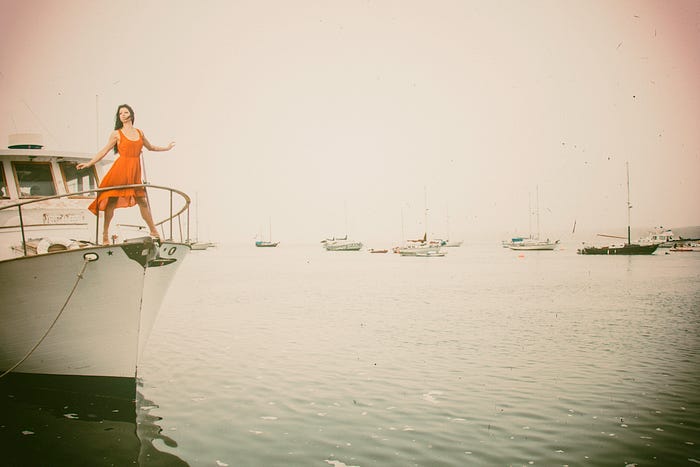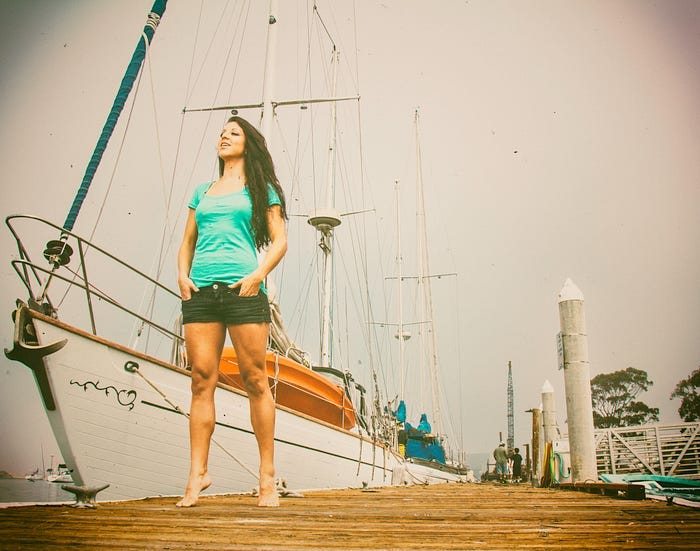At Some Point, You are Going to Want to Quit
I have been at that precipice many times. Here’s what I did.
I wanted to play the drums from the moment I laid eyes on a set of candy-apple-red Ludwigs. All metal-flaked and shiny… and wow — they were unbelievably beautiful, and I wanted to have a set like that.
I got a pair of sticks, and a huge stack of old magazines and began to pound them along with songs on the radio.
I got my cues from watching my friend with the Ludwigs and learned which hand did what and how to train my feet.
(The first song I ever learned was Love Potion Number Nine. Then came the Beatles library, the Stones, and Dave Clark. Then I heard jazz.)
I pounded on magazines, books, my thighs (the jeans helped keep the welts at a minimum), and eventually, my mom took me downtown Phoenix and bought me a set of sparkly silver drums from a pawn shop.
They were cheap, they were awful, but they were mine. And my mom was so proud.
(I played those things for ten years. I modified the heads, put my own baffles in, and nearly rebuilt the entire set to make them sound better.)
I played day and night. I would put towels on the heads to keep the sound muffled. I wanted to play so badly that it made every day an exciting — and equally frustrating — learning experience.
One evening, I sat at the feet of Buddy Rich when his band played in Mesa. Literally at his feet.
I went home and put the drum set in the garage.
I quit.
A week or so went by, and my need to play was driving me crazy.
I got them out, set them up more like Buddy had his set put together, and began working on technique more than ever.
I played in jazz bands for 10 years. I still play. And I still practice.
Photography came along as I was playing drums for a band that toured. I would sit in hotel rooms all day while waiting for the gig to start.
I discovered that hotels are not overly excited about drummers practicing in the rooms, so I would grab a camera and hit the streets while my bandmates played their guitars and such and drank a lot.
I fell deeply in love with making photographs as I began to absolutely loathe being on the road with the band.
(Be careful what you wish for. I had wanted to be in a professional band for so long, and when it finally happened I found that being on the road and bored for 20 hours a day sucked.)
I began shooting more and more and eventually talked (flat-out lied, actually) my way into a gig as a junior art director for a small agency in the LA area. I had to choose between the band and the art world, and I made that choice.
I knew I wanted to be a photographer, and this was a way to hang out with great photographers while learning the business.
And then one day I quit and went full-time photographer.
And I discovered the other part of being a full-time photographer… that it was friggin’ hard to find clients. And it was expensive to gear up.
I went from having money to not having money, and I wanted to quit.
Then a small client became a big client, and we started shooting more and more and the gigs started coming in faster, with larger budgets.
Got a studio in the Melrose area before it was ‘THE MELROSE AREA’ and started building a solid business.
I was on a shoot in Santa Barbara when a group of nice people decided that they needed my gear more than I did, and relieved me of all that stuff by actually pulling the security door off the wall in the alley entrance and cleaning the studio out. They even took the phone off the wall.
I wanted to quit.
I moved back to Phoenix, where my wife had been offered a job, and began looking for assistant work.
I had my Nikons, a pair of Dynalites, a tripod, and a few odds and ends.
At one point, I took a school portrait gig. I wore a clip-on tie and took photographs of kids for 8 hours a day.
Then they asked me to go to the reservations up north to shoot the little schools there. Upped my pay, and off I went to spend weeks at a time in Gallup, New Mexico, Page, Arizona, and Kyenta, Arizona.
The schools were small, and I was finished by 10 AM. I spent the rest of the day shooting around the area and making some new friends. It was like being paid to make my new work.
The portfolio I made doing this made my first assignment in Phoenix happen. Editorial for a magazine in Palm Springs. The story was about the drought in Southern California.
I was back.
After a while, I had a big studio going in Phoenix and was shooting 6–7 days a week. From garage door openers to fashion to food. I had a staff of several people, a full-time darkroom printer, and an assistant or two.
One day I awakened with the knowledge that I had tens of thousands of dollars in receivables and only a couple of grand in the bank. My previous months had been incredibly busy, and ad agencies had a 60–90 day payout schedule.
And I had a payroll.
I could take it out of my savings (and I did), but that really pissed me off.
Getting to the studio and finding two messages from clients who wanted big shoots to happen soon, but still owed me tens of thousands of dollars, I got pissed.
I wanted to quit.
I wasn't a photographer anymore, I was a goddam bank.
Instead, I began working for direct clients. I went after the same clients that the agencies were going after. DIRECT client work.
A few short years later, I owned the third-largest ad agency in Phoenix and was working for international clients.
And then the dotbomb… and we folded, and I went from having money to not having money… and I wanted to quit.
But I didn’t.
I can’t.
You can’t.
My design and photography studio, Steel Design, became quite successful, and I did that up to the point where I started mentoring and teaching.
Had I quit all those years ago, I wonder where I would be now.
Probably not.
Maybe I would be a successful real estate broker.
Or possibly a super-rich investor.
Or an itinerant drummer with a broken-down set of Sonors… who knows.
The point is that no matter what you want to do, you will face times when you want to quit.
If you do, you cut yourself off from the possibilities.
Adjust.
Modify.
Change direction slightly.
Find a way to get around it.
Choose to face the challenge.
Only quit when you know you need to, or find yourself feeling down and know for sure it is time to hang it up.
Never quit when you have had a bad day.
There were more times when I wanted to quit and actually did quit.
I quit the music business, and I quit wasting time at university
But the overall trajectory has been to face adversity, find a way around, over, under, or through it — and keep on doing what I love to do.
If you are lucky enough to do what you love to do, and it is in the creative industry, I can guarantee you one thing.
You will want to quit.








